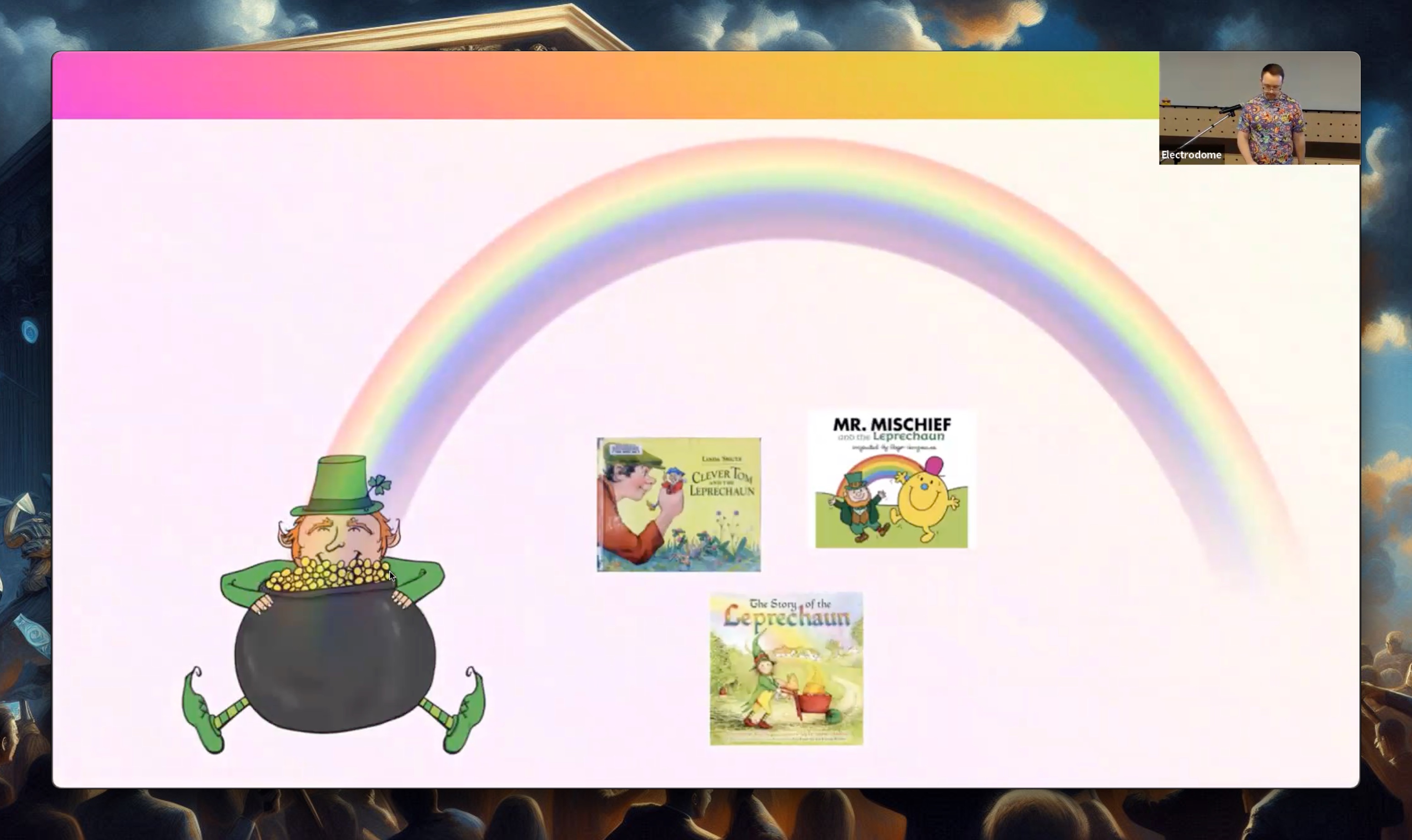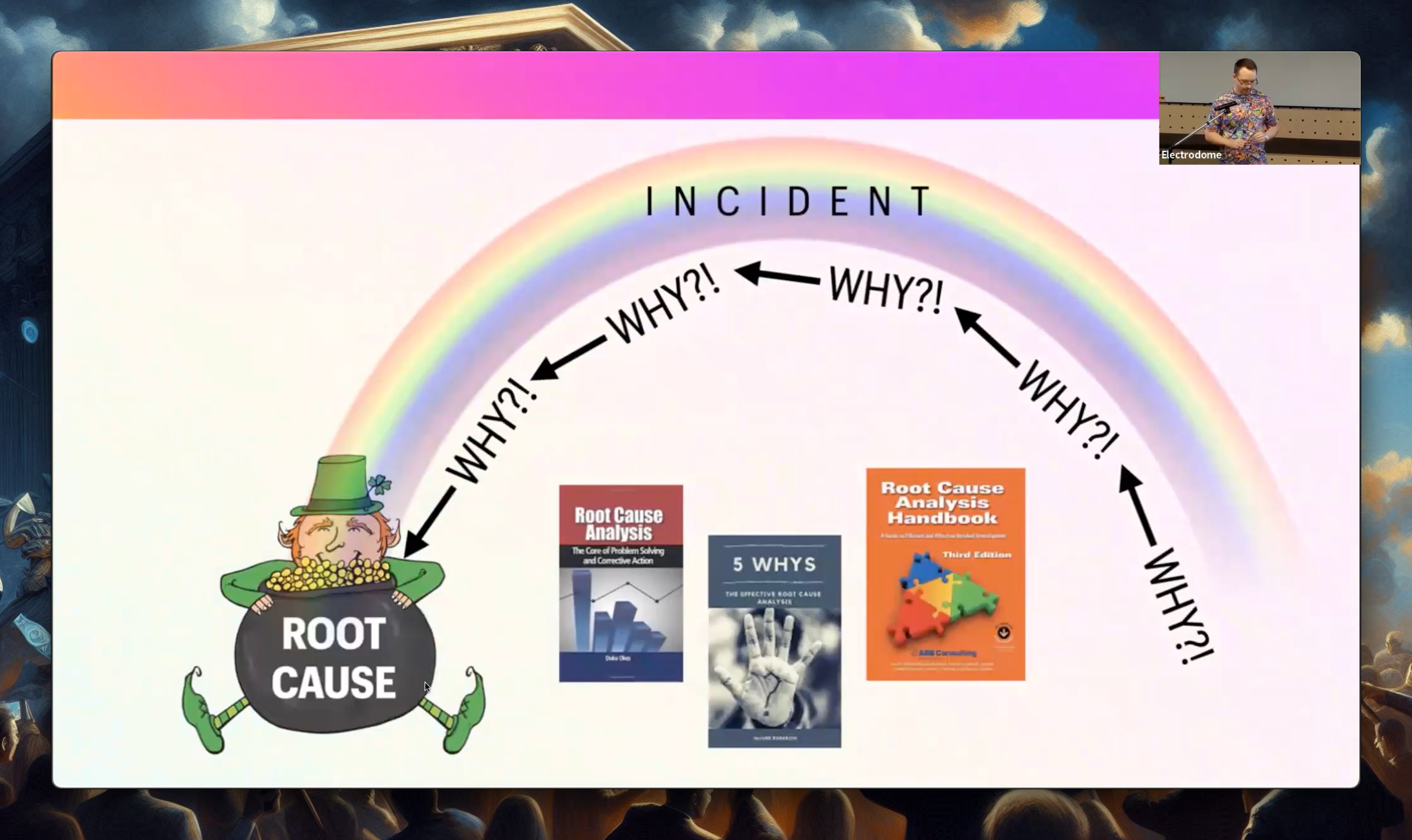This is a short talk I gave a while ago about how complex systems fail, and root cause analysis. Transcript is below.
Transcript
We’re going to talk about root causes today, but since I only have about 10 minutes, I wanted to start with some stories from a book I’m writing called Bedtime Stories To Put Your Children To Sleep Instantly And Also Yourself.

This first story is about leprechauns. Once upon a time, there was a company with a new employee, and one day the employee asked their manager “why does everyone suddenly get in their cars as soon as it stops raining?”.
The manager said “it’s not about when the rain stops. It’s about when the rainbow appears. Common sense tells us that rainbows are produced by a pot of gold left on the ground by a Leprechaun. Everyone knows this — just go ask your Irish ancestor from the 11th century. It’s in books and stuff. But anyway, so, whenever we see a rainbow our proceedure is to trace it back to its source and get the gold. And when we get enough gold, we can all quit our jobs and we won’t have to work anymore.”
The employee walked away from that conversation thinking: how come everyone’s still at work if they’ve been finding all these pots of gold? The end.

Now for a completed different story. Once upon a time, there was a software company with a new employee. And one day the employee asked their manager “why does everyone do root cause analysis after an incident?”
And the manager said “well, common sense tells us that every incident has a root cause. And everyone knows this — just ask people in the industry. It’s in books and stuff. But anyway, whenever we have an incident, our proceedure is to ask the five whys. Why?! Why?! Why?! Why?! Why?! Why did this happen to us?! And that allows us to trace the incident back to its root cause, so that we can eliminate it. And once we’ve eliminated all the root causes, we won’t have any incidents anymore.”
The employee walked away from this conversation thinking: how come we have so many incidents if we’ve been eliminating root causes this whole time? The end.
So thanks for listening to my stories. Book coming soon. Now I’ll get on with my talk: Leprechauns, Root Causes, And Other Fairy Tales.
This talk is largely based on a well-known paper called How Complex Systems Fail by Richard Cook. It’s only three pages long, so I’d encourage everyone here to give it a read. And while making this talk, I found out that someone has turned it into a website: https://how.complexsystems.fail, which is nice. Whenever you hear me say “complex system” in this talk, think of something like a bank or a large system of software. Let’s look at a few points the paper makes.
Complex systems are intrinsically hazardous systems
What this is basically saying is that incidents arise from complexity. It doesn’t matter how many root causes you fix — if you have a sufficiently complex system there will always be problems.
Complex systems run in degraded mode
So if complexity is the cause of problems, then you would expect complex systems to be constantly experiencing problems, and that is exactly what you find when you look at any complicated system. Major incidents might be rare, but minor failures are happening all the time.
Complex systems are heavily and successfully defended against failure
So if they’re constantly having all these problems, you would expect them to grind to a halt and die, but they don’t. And that’s because every complex system has a multitude of defenses that protect it from small localised failures cascading into major system-wide failures. So every complex system has these, and they wouldn’t be able to exist if they didn’t have them.
Catastrophe requires multiple failures — single point failures are not enough
So if they have all these defenses against problems, how come major incidents are still possible? That’s because each individual layer of defense is not perfect. When one layer fails, usually it gets caught by a different layer, but sometimes it will slip through several layers of defense before getting caught. So to get a really nasty major incident, you have to have several failures all line up perfectly to allow that to slip through.
And that kind of brings us to the heart of this talk, so I’m going to read verbatim from the paper at this point (emphasis mine).
Post-accident attribution to a ‘root cause’ is fundamentally wrong.
Because overt failure requires multiple faults, there is no isolated ‘cause’ of an accident. There are multiple contributors to accidents. Each of these is necessarily insufficient in itself to create an accident. Only jointly are these causes sufficient to create an accident. Indeed, it is the linking of these causes together that creates the circumstances required for the accident. This, no isolation of ‘root cause’ of an accident is possible. The evaluations based on such reasoning as ‘root cause’ do not reflect a technical understanding of the nature of failure but rather the social, cultural need to blame specific, localized forces or events for outcomes.
The paper goes on to say that:
Views of ‘cause’ limit the effectiveness of defenses against future events
So when you go hunting for a root cause, you always find one, but the problem is that you always find one. And this fulfils the social need to place blame on something, but it doesn’t necessarily help to reduce the risk of future incidents.
An earlier quote from the paper said that hazard arises from complexity. And what do we do when we fix a root cause? We fix it by adding new rules, new processes, new checks and guards — in other words, new complexity — to the system. So, ironically, every time we try to fix a root cause and reduce our risk, we may accidentally be increasing our risk by adding complexity.
I want to leave a couple of things with you, from this talk.
The paper says “the social need to blame” but I think “scapegoating” is a punchier term. So whenever you hear someone say “root cause” you can take that part of the sentence, replace it with the word “scapegoat”, and it will still make sense. I guarantee that the sentence will still make sense. And it should give you a new perspective on the conversation you’re having, as well.
I didn’t have time to talk about good alternatives, but I would recommend Swiss cheese. You can google “the Swiss cheese model of accident causation” or just come talk to me later.
And if you take anything from this talk, I hope it’s this: root causes are like leprechauns — fun to think about, but completely fictional.
Thank you.